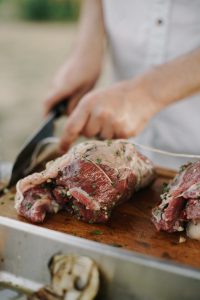
Photo by Max Delsid on Unsplash
By Dr. Christopher R. Raines, Assistant Professor, Department of Dairy & Animal Science, Pennsylvania State University
No, the butcher probably did not keep your meat.
Ever since the first butcher processed a meat animal, the customer has wondered what happened to some of their meat. How could it be that a 1,200 pound steer left you with only 475 pounds of beef? Or that a 250 pound hog generated only 125 pounds of pork? What might seem like a reasonable answer – that the butcher kept your meat – is very unlikely. Take into consideration what happens during the conversion of a market animal into cut and packaged meat, and chances are the math will make more sense. This brief guide is intended to serve as a general base for meat product return and may not fully account for slight variations that different animals and butcher orders may incur.
Dressing percentage (DP) relates the weight of the carcass to the weight of the live animal and is calculated as:
Step 1: Converting an animal into a carcass
(Carcass Weight ÷ Live Weight) × 100. This can be affected by many things, such as gut fill, fatness, mud on the hide, or shorn versus unshorn. Very fat animals have higher dressing percentages than light very lean animals.
- The average dressing percentage for hogs is about 70-72%.
Example: Live weight = 245 lbs. Actual DP = 72% Carcass wt. = 176 lbs.
- The average dressing percentage for cattle is about 50-58%.
Example: Live weight = 1312 lbs. Actual DP = 50% Carcass wt. = 656 lbs. - The average dressing percentage for sheep is about 50%.
Example: Live weight = 127 lbs. Actual DP = 52% Carcass wt. = 66 lbs.
Step 2: Making cuts out of a carcass
This is where it starts to get tricky to predict just how much meat the carcass will yield because that depends largely on how you order the meat cut. Bone-in or boneless? Opting for boneless cuts will reduce your total pounds of meat returned. Do you want ground meat with 10% fat or 20% fat? Lower fat content ground meat will result in more discarded fat, thus reduced total pounds of product received. Was the animal overly fat to begin with? If the animal was fat fromthe start, more fat will need to be trimmed away, thus reducing total pounds of meat returned.
Pork, Beef, and Lamb
- For bone-in pork, expect no more than 75-80% of the carcass weight back as meat.
For boneless, 65-70%.
Example: Carcass weight = 176 lbs. Boneless pork = 123 lbs. - For bone-in beef, expect no more than 65-70% of the carcass weight back as meat.
For boneless, 55-60%.
Example: Carcass weight = 656 lbs. Boneless beef = 393 lbs. - Most lamb cuts are bone-in. Expect no more than 70-75% of carcass weight back as meat.
Example: Carcass weight = 66 lbs. Lamb cuts = 50 lbs.
Step 3: Aging and further processing (optional)
The longer a whole carcass ages (hangs), the more moisture it loses due to evaporation, thus losing weight. Instead of aging an entire carcass for > 2 weeks, ask if your butcher is willing to age just the middle meats. aged.
Ordering bacon? Cured hams? Smoked sausages? Applying a heat process to meat cuts will also reduce the total yield of meat returned from an animal. Different products have different yields.
If you have questions about meat, our experienced staff have answers! Contact us.


